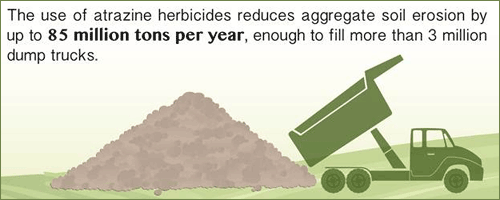Greensboro, North Carolina, USA
February 2, 2012
Findings from three new studies on atrazine’s economic and environmental benefits will be among the presentations at the 2012 Weed Science Society Annual Meeting Feb.6 through 9 in Waikoloa, Hawaii. The studies show atrazine — a popular herbicide long used for managing weeds — not only boosts crop yields and the U.S. economy, it is essential to conservation.

In his paper, “A biological analysis of the use and benefits of chloro-s-triazine herbicides in U.S. corn and sorghum production,” David C. Bridges, Ph.D., agronomist and president, Abraham Baldwin Agricultural College, Tifton, Ga., found:
- Atrazine increases U.S. corn output by 600 million bushels per year and sorghum yield by more than 13 bushels per acre.
- Atrazine benefits field corn farmers up to $2.9 billion annually.
- Atrazine provides irreplaceable benefits to farmers of field corn, sweet corn and grain sorghum, including application flexibility, crop tolerance, weed control and tillage compatibility.
“There is no good substitute for atrazine,” said Bridges. “It’s an off-patent, affordable and well-understood product. This trusted herbicide is a vital tool for controlling weeds in corn, sorghum and sugar cane, and significantly increases yields.”
Atrazine is a critical component in more than 60 agricultural products used by U.S. farmers.
Two other papers — “Economic assessment of the benefits of chloro-s-triazine herbicides to U.S. corn, sorghum, and sugar cane producers” and “Estimating soil erosion and fuel use changes and their monetary values with AGSIM: A case study for triazine herbicides” — by economist Paul D. Mitchell, Ph.D., associate professor, Department of Agricultural and Applied Economics at the University of Wisconsin-Madison, found:
- Atrazine and chloro-s-triazines simazine and propazine benefit U.S. corn, sorghum and sugar cane farmers up to $3.3 billion in value annually.
- Atrazine benefits U.S. consumers by up to $4.8 billion annually, due to increased yield as well as decreased producer costs and reduced soil erosion.
- Atrazine and its sister triazines encourage conservation tillage and no-till farming, which reduce soil erosion, reduce fuel use and improve water quality.
- The triazines prevent up to 85 million metric tons of soil erosion per year – enough to fill more than 3 million dump trucks.
- Atrazine and its sister triazines help reduce emissions by up to 280,000 metric tons of CO2 per year.
“Many people don't realize that herbicides are a critical instrument for protecting wildlife, saving habitat and reducing soil erosion to help keep our waters clean,” said Mitchell. “Thanks to atrazine and its sister triazines, farmers are able to grow more with less.”
Before becoming president of Abraham Baldwin Agricultural College in 2006, Bridges served as faculty member and administrator at the University of Georgia. He holds a bachelor’s degree in agronomy and soils and master’s degree in weed science from Auburn University. He earned a doctorate in weed science from Texas A&M University. He has devoted much of his career to enumerating the use and benefits associated with pest management and crop protection products.
Mitchell grew up on his family’s farm in Iowa and received his doctorate from Iowa State University. Before joining University of Wisconsin-Madison, he was an assistant professor in the Department of Agricultural Economics at Texas A&M University. His current research and outreach programs focus on the farm-level economics of crop production, emphasizing pest management, risk management and specialty crop economics.
Bridges’ and Mitchell’s papers are part of a broad assessment by Syngenta, the principal registrant, to examine the value of atrazine in today’s agricultural economy. Other papers include:
For more information about atrazine, visit www.atrazine.com.
To learn more about the benefits of atrazine, go to www.atrazine.com/benefitsgraph.
The Weed Science Society of America, a nonprofit professional group, was founded in 1956 to encourage and promote the development of knowledge concerning weeds and their impact on the environment. The organization promotes research, education and extension outreach activities related to weeds; provides science-based information to the public and policy makers; fosters awareness of weeds and their impacts on managed and natural ecosystems; and promotes cooperation among weed science organizations across the nation and around the world.